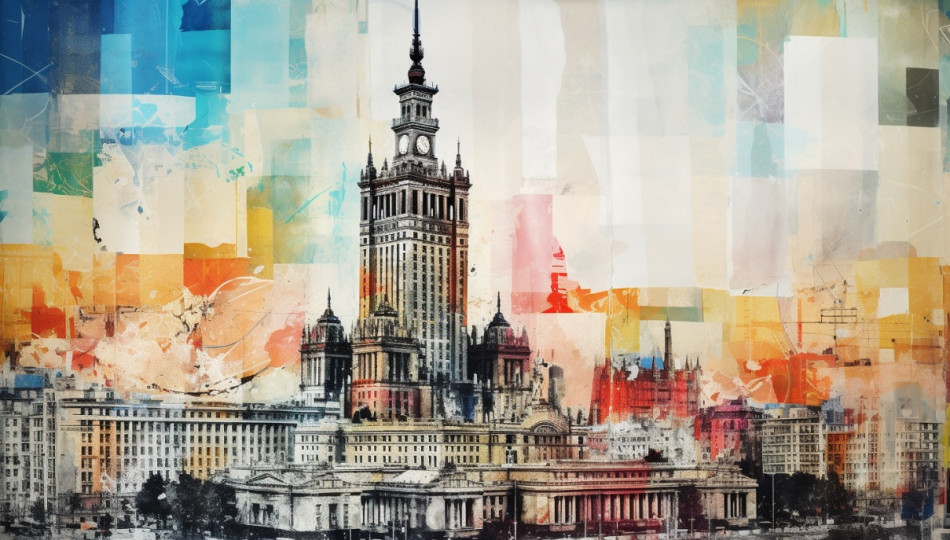To relish or demolish? Palace of Culture and Science in Warsaw

Editor

Generated in Midjourney
related articles
History – From Moskov with (Leader’s) Love
Before we delve into the reasons why the Palace of Culture and Science should be razed to the ground, it’s important to understand the circumstances in which it was first raised.
The Palace of Culture and Science was not begotten as a dwelling of a royal family, as palaces usually tend to be. It in fact originated in 1950’s in the mind of one Lev Rudnev, a Soviet architect. Rudnev, having designed seven other buildings in a similar Social Classicism style – those are known as Moskov's Seven Sisters – was given a commission to create another one, this time in Poland. Apparently, Rudnev decided not to mess with the good thing – “if it ain’t broke, fix it”, right? – and created a building so similar in its shape and style to its Moskov predecessors, that it’s informally called “The Eight Sister”. Interestingly, other nicknames used to describe PKiN include “Syringe” (pol. strzykawka,) “The Russian wedding cake” (pol. ruski tort) and “Mad Confectioner's Dream" (pol. sen szalonego cukiernika). These monikers seem to be very bakery-oriented, yet somehow surprisingly apt: after all, the “confectioner” behind this idea was Joseph Stalin himself.
The building was officially named “The Palace of Culture and Science in the name of Joseph Stalin” and was announced as a “gift of the Soviet people to the Polish nation”. A gift, truthfully, that no one ever desired or liked, but then again, this is Stalin we are talking about. As we all know, Stalin's less-than-stellar gift-giving skills were the least of his problems.
There is a coalition for its demolition
Those who support the idea of destroying The Palace of Culture usually cite one of the following reasons:
-
Good Bye, Stalin! – It’s a symbol of Socialism
The fact that a building created by a foreign invader still stands in the middle of Poland’s capital, and moreover, it’s de facto one of the city's most recognizable landmarks, can be deeply troubling. It can be seen as the commemoration, and even celebration, of an oppressive and totalitarian regime –a tangible symbol of Soviet domination looming over the city.
Demolishing the palace could therefore be perceived as Poland’s cultural independence, a step towards breaking free from the dark shadow of the Soviet Union’s governance.
-
Bills, Bills, Bills! – It’s expensive to maintain
Fun fact: the Palace has 42 floors and whooping 3288 rooms! Decidedly less fun, though, are the utility bills the city must pay for each of those rooms.
The maintenance of such a massive structure can be financially burdensome. What is more, the money spent on the upkeep of the palace could be feasibly better used somewhere else. There are plenty of other projects, infrastructure or cultural, that could better serve the city’s needs and would be more economically sustainable.
-
It ain’t pretty
There is no getting around this – while this is hardly the ugliest building in the world, it won’t win any beauty contest either. The architectural style of Soviet Classicism is rather stocky, blocky, and whatever -ocky ending word you want to insert here. And if you don’t like the style, well, then sorry bud, but you’re out of luck! The structure is enormous – and with its height of 42 floors and 237 meters – it is very visible on the city horizon.
According to one Polish joke, the most beautiful place in Warsaw is the viewing terrace on 30th floor of the Palace of Culture. And no, it is not because of the beautiful city vista it offers. It’s simply the only spot from where you can see anything but the Palace.
A part of the nation is for preservation
The opposition to the idea of the palace’s demolition usually uses one of the following arguments:
-
The Road to Freedom – It’s a symbol of overcoming impossible odds
The Palace of Culture, a real-life embodiment of Poland's complicated relationship with the Soviet Union, serves as a reminder of the country’s struggle for independence as well as a testament to the indomitable spirit of its people. Therefore, preserving the palace could allow future generations to understand the complexities of Poland’s past and appreciate the difficult road to freedom the people before them had to travel.
-
“I’ve seen things you people wouldn’t believe…” – It has been a witness to many historical events
While the Palace of Culture might have started as Stalin’s unsolicited “gift” for some people this is a skin it shed a long time ago. The Palace’s walls hold the memories of pivotal moments in Polish history, like political gatherings, exhibitions and artistic performances. It is a place where the Iron Curtain was – perhaps not quite breached, but temporarily lifted – when in 1967 the Rolling Stones performed as the first major Western rock band.
-
Culture Vultures, assemble! – It’s a cultural and entertainment meeting ground
As we have established, there are literally thousands of rooms in the palace, and some of them are used very well, indeed. Nowadays, PKiN is home to theaters, both the traditional and the movie kind, the main Warsaw Tourist Information office, museums, and popular pubs. Last but not least, it has a freaking swimming pool. ‘Nuff said.
The final verdict? – The jury is still out...
The decision of whether to relish or demolish the Palace of Culture in Warsaw is not an easy one to make. The public debate about the palace’s fate has been something of a recurring event, yet still, there is no sight of its resolution nor an end.
It’s a complex and emotionally charged matter, where two opposite fractions, both presenting reasonable and important values, are torn between honoring historical significance and embracing a future free from the shackles of the past. While the palace reminds us of an important chapter in Poland's journey, it’s a chapter that many might wish to close.
All in all, the beauty is, as always, in the eye of the beholder. For some, the Palace of Culture might be a sight for sore eyes. For others, it will forever remain an eyesore.












